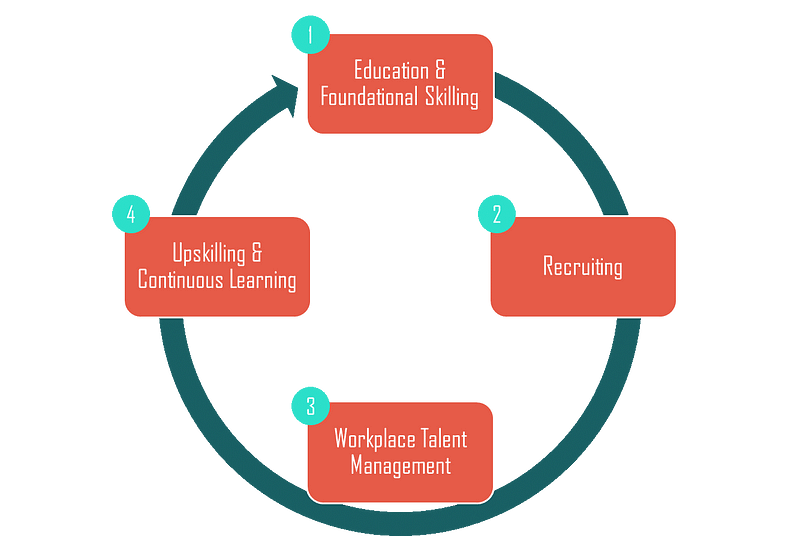Lifting the Labor Force: Trends in Workforce Technology
A much-quoted statistic goes something like this: “65% of children entering primary school today will ultimately end up working in… Workforce technology is transforming the labor market via enterprise SaaS, artificial intelligence, two-sided market places, and more. How does industry keep up?

A much-quoted statistic goes something like this: “65% of children entering primary school today will ultimately end up working in completely new job types that don’t yet exist.” While the accuracy of the claim is undetermined, the underlying importance on workforce development it that it suggests is very much certain. Due to disruptive technological innovations, traditional industries and professions will completely transform and change the workforce as we know it today.
The tried-and-true examples of skills and job categories are familiar: artificial intelligence, robotics, 3D printing, software development, and so on. However, above all of this is a burgeoning trend that is become an industry segment all unto itself: workforce technology. According to a 2018 study by LearnLaunch, there is a jolt of interest in the education technology market for workforce technology. Startups targeting the workplace segment (~250 in the US) collectively raised $1.4B for content and technology for workforce development between 2015 and 2017.
As workforce technology has solidified itself as an industry segment, so too have software companies begun innovating on the labor lifecycle as a result. One can already see how each stage in the labor market has been affected and influenced by startups focused on education and marketplace efficiency.
There are arguably four main stages of the labor cycle that workforce technology is disrupting. These stages span formal/informal education, job placement, and the workplace in general:

1. Education and Foundational Skilling. Educating students to develop their skills to make them desirable and well-equipped in the job market. The main transformations in this stage have included massive open online courses, micro-credentialing, and virtual learning technology.
2. Recruiting. The placement of skilled workers in corresponding roles in industry. This industry has been completely transformed through the advent of multi-channel communication, big data, analytics, and automation.
3. Workplace Talent Management. Working with newly hired candidates to transfer knowledge and ramp them up on internal processes (benefits, payroll, compensation, performance management, and the like). This stage has been particularly enhanced through big data and analytics and software-as-a-service as well, but also emerging in this space is virtual and augmented reality.
4. Upskilling and Continuous Learning. This is a return, in a way, to the first stage and completes the labor cycle. Workers in today’s market will continue to upskill and train as their jobs are influenced by technology innovation and automation.
Several key trends and corresponding challenges are becoming prominent within the workforce development lifecycle today:
Enterprise SaaS has made each of the lifecycle stages more efficient and data-driven for industry.
Opportunity: Providing actionable insights quick enough to prevent employee turnover is still an untapped function.
The advantage of the rising trend of SaaS systems in the corporate HR function is even more data. Joyce Chen, Thomson Reuters’ Global Director of Emerging Technologies puts it nicely in an article from CIO Magazine:
“By marrying proprietary data and open data, an organization and HR team can better understand how employees and teams work together, what type of employees performs better and in what organizational environment, and how the organization’s reputation and culture compare to its competitors.”
Something that platforms trying to leverage this data will need to implement are real-time metrics that allow managers to act on employee feedback quickly. Utilizing compensation, performance, and cultural data, companies can become agile and responsive to employee concerns in an increasingly competitive job market.
Machine learning algorithms and artificial intelligence will continue to automate different nodes in the lifecycle, particularly in recruiting and job placement.
Opportunity: The efficiency and efficacy of the labor marketplace remains a significant bottleneck in the recruiting process.
Job placement is perhaps the most inefficient, expensive node in the labor process outlined above and it has an outsized macroeconomic effect. By creating efficient marketplaces to connect the labor pool with other stakeholder groups (educators, recruiters, hiring managers), technology platforms can solve this bottleneck. Efficiency can be achieved through a variety of methods, among them being proprietary matching algorithms, strategic partnerships with recruiters and hiring managers, a deeply vetted talent pool, automation, and more. Technology will undoubtedly have an impact on talent acquisition going forward, and hiring managers and recruiters will need to equip themselves with the right tools to find talent quickly. In a recent Forbes article the opportunity is summarized like this:
“The trend toward automating hiring has companies developing software to take bias and discrimination out of the processes, as well as reduce costs and speed the time to hire…This means recruiters can spend less time vetting candidates and more time focusing on strategic recruiting.”
Examples: RigUp, WorkingNotWorking
The rise of technology-driven, short-term certification and training programs will make the labor force and industry better equipped to handle rapidly changing tides in the economy.
Opportunity: A challenge here is how hiring managers identify the legitimacy of said programs and make calculated decisions.
In these training programs, employers must be involved from the very beginning of the educational journey. While this is obvious for internal training programs, the real challenge is making it a reality in short-term credentialing programs and other “third-wave” education programs like coding bootcamps and professional schools. The next step is to work with these employers to identify the skills in demand. A recent McKinsey study states:
“Once providers decide which sectors and which high-scarcity or high-turnover professions to pursue, the next step is to shadow employees on the job in those professions. The goal is to identify which activities most differentiate high from low performers and to translate this insight into training for the right technical, behavioral, and mind-set skills which include attributes such as punctuality, diligence, and follow-through).”
Examples: Flatiron School, Lynda
The ways in which industries focus on the workforce development cycle will determine the competitive landscape in the global economy. The same McKinsey study paints an urgent picture:
“On the one hand, almost 40 percent of American employers say they cannot find people with the skills they need, even for entry-level jobs. Almost 60 percent complain of lack of preparation, even for entry-level jobs. On the other hand, this “skills gap” represents a massive pool of untapped talent, and it has dire consequences, including economic underperformance, social unrest, and individual despair.”
The great thing about “dire consequences” are the innovations that spring up to prevent them. It will be exciting to see how emerging and established technology companies contribute to tackling these challenges in the next few years.
Have feedback or thoughts on this article? Feel free to reach out to me via e-mail or leave a comment below to continue the discussion.